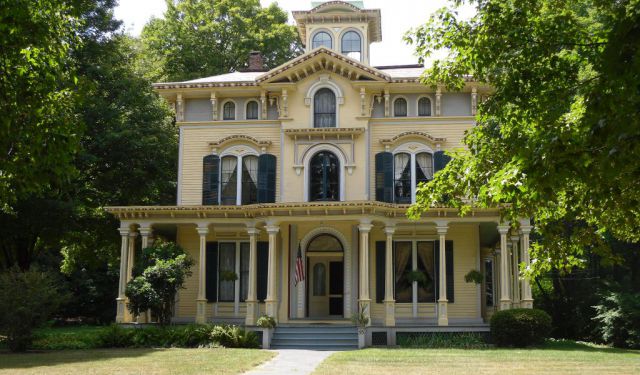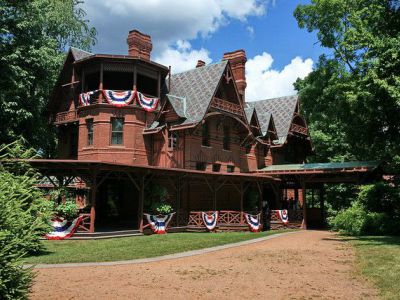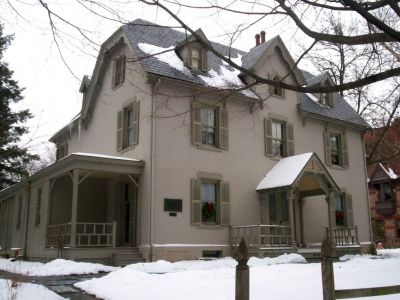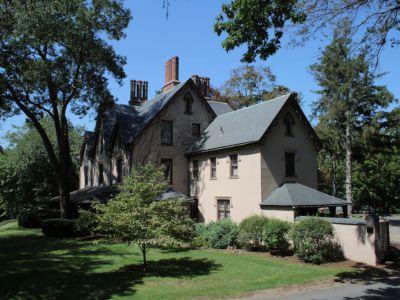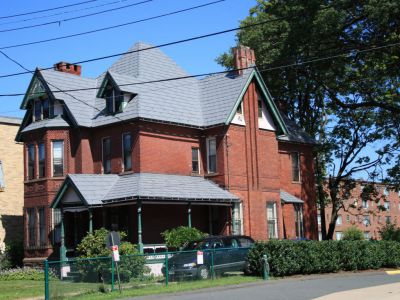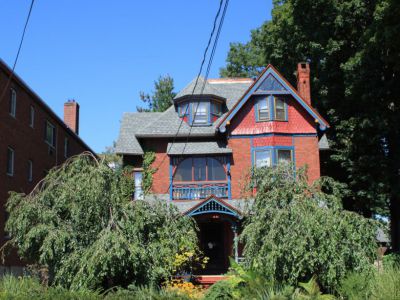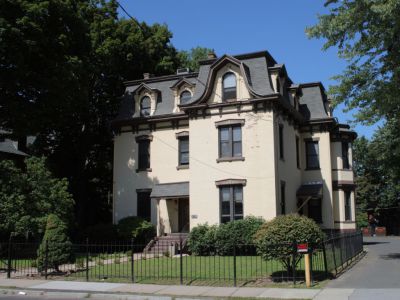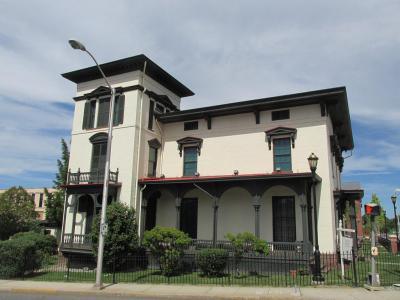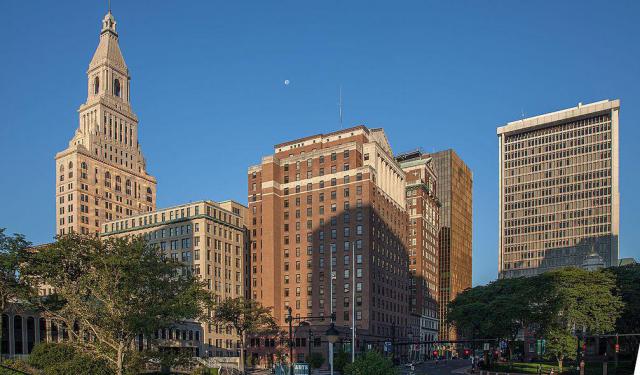Hartford's Historical Houses Tour (Self Guided), Hartford
Visiting old houses is like treasure hunting, where you are bound to uncover secrets of the former owners. Hartford was once home to well-known historic figures, whose abodes today have been converted into museums for future generations to explore.
Among these is the Mark Twain House, a former residence of the iconic American author Samuel Clemens, better known as Mark Twain. This Victorian Gothic property showcases the author's life and works, offering visitors a unique insight into his literary genius.
Adjacent to the Mark Twain House is the Harriet Beecher Stowe House, where the influential author of "Uncle Tom's Cabin" once resided. This historic landmark provides a window into Stowe's abolitionist beliefs and her impact on American literature and social justice.
The Perkins-Clark House, with its elegant Gothic Revival architecture, stands as a testament to Hartford's colonial heritage. Built in the mid-19th century, it is associated with Charles Perkins, lawyer to author Samuel Clemens, and is listed on the National Register of Historic Places.
The William L Linke House, located on Sigourney Street, is another architectural gem in Hartford. This Queen Anne-style mansion showcases the opulence of the Gilded Age and the affluent lifestyle of Hartford's elite at the turn of the 20th century.
The buildings at 142 Collins Street and 136-138 Collins Street are fine examples of Hartford's historic residential architecture, each with its unique charm and character.
Finally, the Isham-Terry House, a grand Italianate mansion, is a historical gem originally built in 1854, largely contributing to the development of Asylum Hill as a desirable neighborhood for Hartford's elites. Donated to Connecticut Landmarks in the 1970s, it now serves as a museum.
Exploring the tapestry of Hartford's historical houses, especially if you're keen to learn about the city's literary luminaries, is a culturally enriching journey in its own right. So, plan your visit today and discover the stories etched in the stones of these notable dwellings for an experience you will surely remember long after!
Among these is the Mark Twain House, a former residence of the iconic American author Samuel Clemens, better known as Mark Twain. This Victorian Gothic property showcases the author's life and works, offering visitors a unique insight into his literary genius.
Adjacent to the Mark Twain House is the Harriet Beecher Stowe House, where the influential author of "Uncle Tom's Cabin" once resided. This historic landmark provides a window into Stowe's abolitionist beliefs and her impact on American literature and social justice.
The Perkins-Clark House, with its elegant Gothic Revival architecture, stands as a testament to Hartford's colonial heritage. Built in the mid-19th century, it is associated with Charles Perkins, lawyer to author Samuel Clemens, and is listed on the National Register of Historic Places.
The William L Linke House, located on Sigourney Street, is another architectural gem in Hartford. This Queen Anne-style mansion showcases the opulence of the Gilded Age and the affluent lifestyle of Hartford's elite at the turn of the 20th century.
The buildings at 142 Collins Street and 136-138 Collins Street are fine examples of Hartford's historic residential architecture, each with its unique charm and character.
Finally, the Isham-Terry House, a grand Italianate mansion, is a historical gem originally built in 1854, largely contributing to the development of Asylum Hill as a desirable neighborhood for Hartford's elites. Donated to Connecticut Landmarks in the 1970s, it now serves as a museum.
Exploring the tapestry of Hartford's historical houses, especially if you're keen to learn about the city's literary luminaries, is a culturally enriching journey in its own right. So, plan your visit today and discover the stories etched in the stones of these notable dwellings for an experience you will surely remember long after!
How it works: Download the app "GPSmyCity: Walks in 1K+ Cities" from Apple App Store or Google Play Store to your mobile phone or tablet. The app turns your mobile device into a personal tour guide and its built-in GPS navigation functions guide you from one tour stop to next. The app works offline, so no data plan is needed when traveling abroad.
Hartford's Historical Houses Tour Map
Guide Name: Hartford's Historical Houses Tour
Guide Location: USA » Hartford (See other walking tours in Hartford)
Guide Type: Self-guided Walking Tour (Sightseeing)
# of Attractions: 7
Tour Duration: 2 Hour(s)
Travel Distance: 3.6 Km or 2.2 Miles
Author: Dee
Sight(s) Featured in This Guide:
Guide Location: USA » Hartford (See other walking tours in Hartford)
Guide Type: Self-guided Walking Tour (Sightseeing)
# of Attractions: 7
Tour Duration: 2 Hour(s)
Travel Distance: 3.6 Km or 2.2 Miles
Author: Dee
Sight(s) Featured in This Guide:
- Mark Twain House
- Harriet Beecher Stowe House
- Perkins-Clark House
- William L. Linke House
- Building at 142 Collins Street
- Building at 136-138 Collins Street
- Isham-Terry House
1) Mark Twain House (must see)
The Mark Twain House and Museum in Hartford was home to celebrated American author Samuel Langhorne Clemens-better known as Mark Twain-from 1874 to 1891. Designed by architect Edward Tuckerman Potter, the mansion reflects the flamboyant American High Gothic style, with its steep gables, ornate woodwork, and asymmetrical layout.
While living in this uniquely expressive home, Twain produced many of his most enduring works, including The Adventures of Tom Sawyer, Adventures of Huckleberry Finn, The Prince and the Pauper, Life on the Mississippi, A Tramp Abroad, and A Connecticut Yankee in King Arthur’s Court. His top-floor billiards room doubled as a private study, where he would retreat at night to write, entertain friends, and, famously, swear in peace.
Twain’s connection to Hartford began in 1868 when he came to work with publisher Elisha Bliss, Jr. of the American Publishing Company. Hartford, then a thriving literary and economic hub with the nation’s highest per-capita income, quickly won Twain’s heart. “Of all the beautiful towns it has been my fortune to see, this is the chief,” he wrote. In 1871, he and his wife Olivia Langdon rented a home in Nook Farm, a neighborhood popular among writers and intellectuals, before building their dream house on the same land.
Completed in 1874, the house soon became a local landmark. The Hartford Daily Times noted its architectural originality and the fame of its owner as reasons for its prominence. Twain continued to pour personality into the home, bringing in Louis Comfort Tiffany to redecorate its interiors in 1881 and embracing new technologies like the telephone.
Despite the house's grandeur and Twain's literary success, financial missteps eventually forced the family to leave in 1891 for Europe, where the cost of living was lower. Twain rented out the Hartford house and returned only once, in 1895. The visit stirred strong emotions. “It is the loveliest home that ever was,” he wrote wistfully.
Today, the Mark Twain House and Museum stands as a tribute to Twain's genius, offering visitors a glimpse into the domestic world where some of America's most iconic literature was born.
While living in this uniquely expressive home, Twain produced many of his most enduring works, including The Adventures of Tom Sawyer, Adventures of Huckleberry Finn, The Prince and the Pauper, Life on the Mississippi, A Tramp Abroad, and A Connecticut Yankee in King Arthur’s Court. His top-floor billiards room doubled as a private study, where he would retreat at night to write, entertain friends, and, famously, swear in peace.
Twain’s connection to Hartford began in 1868 when he came to work with publisher Elisha Bliss, Jr. of the American Publishing Company. Hartford, then a thriving literary and economic hub with the nation’s highest per-capita income, quickly won Twain’s heart. “Of all the beautiful towns it has been my fortune to see, this is the chief,” he wrote. In 1871, he and his wife Olivia Langdon rented a home in Nook Farm, a neighborhood popular among writers and intellectuals, before building their dream house on the same land.
Completed in 1874, the house soon became a local landmark. The Hartford Daily Times noted its architectural originality and the fame of its owner as reasons for its prominence. Twain continued to pour personality into the home, bringing in Louis Comfort Tiffany to redecorate its interiors in 1881 and embracing new technologies like the telephone.
Despite the house's grandeur and Twain's literary success, financial missteps eventually forced the family to leave in 1891 for Europe, where the cost of living was lower. Twain rented out the Hartford house and returned only once, in 1895. The visit stirred strong emotions. “It is the loveliest home that ever was,” he wrote wistfully.
Today, the Mark Twain House and Museum stands as a tribute to Twain's genius, offering visitors a glimpse into the domestic world where some of America's most iconic literature was born.
2) Harriet Beecher Stowe House (must see)
The Harriet Beecher Stowe House in Hartford is a historic house museum and National Historic Landmark that was home to one of America’s most influential writers. Located on Forest Street, right next to the Mark Twain House, this 5,000-square-foot, cottage-style residence was where Harriet Beecher Stowe-author of Uncle Tom’s Cabin-lived for the final 23 years of her life.
Built during the turbulent years of the American Civil War, the house reflects both the literary legacy and domestic life of its famous residents. Stowe herself oversaw much of its construction, joyfully immersed in the practical challenges of creating a home. In a letter to her publisher, she wrote with characteristic wit about her involvement: “I am busy with drains sewers sinks digging trenching-& above all with manure!” Despite the wartime shortages and setbacks, the house was sufficiently complete by spring 1864 for her to begin writing from its sunny bow window.
Architecturally, the two-story brick house stands on a brick foundation and features a mix of Gothic Revival and Italianate styles, with a jerkin-headed gable, hip-roof extension, and decorative elements like bargeboard trim and Italianate brackets. Inside, it follows a traditional center hall plan, with parlors, a dining room, a kitchen, and pantry on the ground floor, and bedrooms upstairs.
During her years in Hartford, Stowe remained a vital cultural figure. She wrote Pogunuc People (1878), went on lecture tours, advocated for the Wadsworth Atheneum, and helped found what is now the Hartford Art School at the University of Hartford. Her home became a place of literary creation, civic engagement, and family life until her death in 1896, in an upstairs bedroom surrounded by loved ones.
The Harriet Beecher Stowe House was added to the National Register of Historic Places in 1970 and declared a National Historic Landmark in 2013. Today, it is open to the public and serves as a place of education and remembrance, celebrating Stowe’s enduring impact on American literature and social reform.
Built during the turbulent years of the American Civil War, the house reflects both the literary legacy and domestic life of its famous residents. Stowe herself oversaw much of its construction, joyfully immersed in the practical challenges of creating a home. In a letter to her publisher, she wrote with characteristic wit about her involvement: “I am busy with drains sewers sinks digging trenching-& above all with manure!” Despite the wartime shortages and setbacks, the house was sufficiently complete by spring 1864 for her to begin writing from its sunny bow window.
Architecturally, the two-story brick house stands on a brick foundation and features a mix of Gothic Revival and Italianate styles, with a jerkin-headed gable, hip-roof extension, and decorative elements like bargeboard trim and Italianate brackets. Inside, it follows a traditional center hall plan, with parlors, a dining room, a kitchen, and pantry on the ground floor, and bedrooms upstairs.
During her years in Hartford, Stowe remained a vital cultural figure. She wrote Pogunuc People (1878), went on lecture tours, advocated for the Wadsworth Atheneum, and helped found what is now the Hartford Art School at the University of Hartford. Her home became a place of literary creation, civic engagement, and family life until her death in 1896, in an upstairs bedroom surrounded by loved ones.
The Harriet Beecher Stowe House was added to the National Register of Historic Places in 1970 and declared a National Historic Landmark in 2013. Today, it is open to the public and serves as a place of education and remembrance, celebrating Stowe’s enduring impact on American literature and social reform.
3) Perkins-Clark House
The Perkins–Clark House, located on Woodland Street in Hartford, is a distinguished example of Gothic Revival residential architecture. Built in 1861, it stands as the last remaining house on what was once a fashionable stretch of Woodland Street. Designed by the architectural firm of Octavius and Augustus Jordan, the house reflects design principles promoted by landscape and architecture visionaries Calvert Vaux and Andrew Jackson Downing, who championed the Gothic villa style.
Commissioned by Charles Perkins, a prominent lawyer and literary figure, the home is closely linked to American cultural history. Perkins was not only the legal representative of Samuel Clemens-better known as Mark Twain-but also a member of the influential Beecher family. His mother, Mary Beecher Perkins, was a sister of famed abolitionist Harriet Beecher Stowe and suffragist Isabella Beecher Hooker. The Jordan brothers also designed homes in Hartford’s Nook Farm for these notable women, though most have since been lost to time.
The Perkins–Clark House is a 2½-story stuccoed structure set on a generous parcel overlooking the Park River. It features steeply pitched gables with ornate bargeboard trim and distinctive brick chimneys with corbelled tops. In 1924, the property was purchased by Probate Judge Walter Clark, who made several additions while carefully preserving the home’s stylistic integrity. Today, the house serves as professional office space, currently occupied by an architectural firm.
Listed on the National Register of Historic Places since 1978 and included within the Nook Farm and Woodland Street Historic District, the Perkins–Clark House is both a physical and historical landmark-offering a glimpse into the artistic, intellectual, and architectural legacies of 19th-century Hartford.
Commissioned by Charles Perkins, a prominent lawyer and literary figure, the home is closely linked to American cultural history. Perkins was not only the legal representative of Samuel Clemens-better known as Mark Twain-but also a member of the influential Beecher family. His mother, Mary Beecher Perkins, was a sister of famed abolitionist Harriet Beecher Stowe and suffragist Isabella Beecher Hooker. The Jordan brothers also designed homes in Hartford’s Nook Farm for these notable women, though most have since been lost to time.
The Perkins–Clark House is a 2½-story stuccoed structure set on a generous parcel overlooking the Park River. It features steeply pitched gables with ornate bargeboard trim and distinctive brick chimneys with corbelled tops. In 1924, the property was purchased by Probate Judge Walter Clark, who made several additions while carefully preserving the home’s stylistic integrity. Today, the house serves as professional office space, currently occupied by an architectural firm.
Listed on the National Register of Historic Places since 1978 and included within the Nook Farm and Woodland Street Historic District, the Perkins–Clark House is both a physical and historical landmark-offering a glimpse into the artistic, intellectual, and architectural legacies of 19th-century Hartford.
4) William L. Linke House
The William L. Linke House, located on Sigourney Street in Hartford, is a notable remnant of late 19th-century residential architecture. Built around 1880, this Queen Anne Victorian is one of the few surviving structures of its kind on a street that was once densely lined with similar homes. It was officially recognized for its historical significance with a listing on the National Register of Historic Places in 1983.
Set in the Asylum Hill neighborhood, the house stands out among the modern multiunit apartment buildings that now dominate the area. Architecturally, the house is a 2½-story masonry building constructed of brick with stone trim, showcasing the asymmetrical forms and ornate detailing characteristic of the Queen Anne style. Its complex roofline includes multiple gables and dormers, while the front porch features turned posts, carved valances, and a prominent gable over the entry. A two-story bay on the left side is adorned with decorative brickwork, and terra cotta panels, and topped by a wooden bay and carved woodwork at the gable peak.
The house represents a once-common architectural pattern in the area. An 1896 map depicts Sigourney Street filled with comparable residences. However, the urban redevelopment of Asylum Hill and the street’s evolution into a key north-south thoroughfare have led to the demolition of most of those homes, making the William L. Linke House a rare and valuable architectural survivor.
Set in the Asylum Hill neighborhood, the house stands out among the modern multiunit apartment buildings that now dominate the area. Architecturally, the house is a 2½-story masonry building constructed of brick with stone trim, showcasing the asymmetrical forms and ornate detailing characteristic of the Queen Anne style. Its complex roofline includes multiple gables and dormers, while the front porch features turned posts, carved valances, and a prominent gable over the entry. A two-story bay on the left side is adorned with decorative brickwork, and terra cotta panels, and topped by a wooden bay and carved woodwork at the gable peak.
The house represents a once-common architectural pattern in the area. An 1896 map depicts Sigourney Street filled with comparable residences. However, the urban redevelopment of Asylum Hill and the street’s evolution into a key north-south thoroughfare have led to the demolition of most of those homes, making the William L. Linke House a rare and valuable architectural survivor.
5) Building at 142 Collins Street
The building at 142 Collins Street in Hartford is a richly detailed Queen Anne Victorian home built around 1890, and a standout example of its architectural style in the Asylum Hill neighborhood. Listed on the National Register of Historic Places in 1979, it reflects a time when this area of Hartford was lined with elegant single-family homes showcasing the ornate tastes of the late 19th century.
Located just east of Summer Street and directly across from the Hartford Insurance Group’s main complex, the 2½-story brick house features a truncated hip roof, punctuated by a mix of projecting gables and dormers. The facade is visually engaging, with stacked front porches-the upper porch confined to the central bay-both adorned with spindled woodwork friezes and turned supports. To the right, a prominent gable projection clad in scalloped shingles frames a distinctive two-window angled bay, adding to the asymmetrical charm typical of Queen Anne design.
Architecturally, 142 Collins Street offers a fascinating contrast with its neighbor at 136–138 Collins Street, a Second Empire–style home built in the 1870s, together representing shifting design trends in Asylum Hill’s evolution. While the exterior remains an excellent example of late Victorian craftsmanship, the interior reveals a balance of historic charm and modern convenience.
Inside, the home is configured as a two-family residence. The main level boasts a remodeled custom kitchen, a formal dining room with original woodwork and sliding pocket doors, and a Rumford fireplace in the living room for cozy evenings. Upstairs, the second floor holds three bedrooms, a full bath, and another period fireplace beneath cathedral ceilings that open from the landing. The third-floor unit, accessible via a private entrance, offers a serene, self-contained living space complete with its kitchen and bathroom.
Blending historical significance, architectural distinction, and residential functionality, 142 Collins Street remains a treasured example of Hartford’s 19th-century domestic heritage.
Located just east of Summer Street and directly across from the Hartford Insurance Group’s main complex, the 2½-story brick house features a truncated hip roof, punctuated by a mix of projecting gables and dormers. The facade is visually engaging, with stacked front porches-the upper porch confined to the central bay-both adorned with spindled woodwork friezes and turned supports. To the right, a prominent gable projection clad in scalloped shingles frames a distinctive two-window angled bay, adding to the asymmetrical charm typical of Queen Anne design.
Architecturally, 142 Collins Street offers a fascinating contrast with its neighbor at 136–138 Collins Street, a Second Empire–style home built in the 1870s, together representing shifting design trends in Asylum Hill’s evolution. While the exterior remains an excellent example of late Victorian craftsmanship, the interior reveals a balance of historic charm and modern convenience.
Inside, the home is configured as a two-family residence. The main level boasts a remodeled custom kitchen, a formal dining room with original woodwork and sliding pocket doors, and a Rumford fireplace in the living room for cozy evenings. Upstairs, the second floor holds three bedrooms, a full bath, and another period fireplace beneath cathedral ceilings that open from the landing. The third-floor unit, accessible via a private entrance, offers a serene, self-contained living space complete with its kitchen and bathroom.
Blending historical significance, architectural distinction, and residential functionality, 142 Collins Street remains a treasured example of Hartford’s 19th-century domestic heritage.
6) Building at 136-138 Collins Street
The building at 136–138 Collins Street in Hartford stands as a rare and distinguished example of Second Empire architecture, a style seldom seen in the city. Constructed around 1870, this 2½-story brick residence is located in the Asylum Hill neighborhood, just east of Sumner Street, and was listed on the National Register of Historic Places in 1982.
Architecturally, the house is defined by its slate mansard roof, which features elaborately carved dormers with round-arched windows, decorative keystones, and scroll brackets. A two-story projecting pavilion on the east side adds further visual interest, and paired brackets under the eaves enhance the vertical emphasis typical of the style. The structure sits atop an elevated basement, giving it a notably tall and stately presence. Its three-bay façade is centered by a main entrance, while windows are adorned with peaked lintels and bracketed sills.
Although the front porch is a 20th-century addition, remnants of the original veranda’s roofline can still be seen, particularly on the western half of the house. Despite this alteration, the building retains much of its original decorative detailing, showcasing a high level of craftsmanship.
Historically, the home was once owned by Isaac Frisbie, who served as superintendent of Hartford’s poorhouse, which formerly stood behind the property on Garden Street. Today, 136–138 Collins Street remains an imposing and stylistically rich reminder of Hartford’s 19th-century residential architecture.
Architecturally, the house is defined by its slate mansard roof, which features elaborately carved dormers with round-arched windows, decorative keystones, and scroll brackets. A two-story projecting pavilion on the east side adds further visual interest, and paired brackets under the eaves enhance the vertical emphasis typical of the style. The structure sits atop an elevated basement, giving it a notably tall and stately presence. Its three-bay façade is centered by a main entrance, while windows are adorned with peaked lintels and bracketed sills.
Although the front porch is a 20th-century addition, remnants of the original veranda’s roofline can still be seen, particularly on the western half of the house. Despite this alteration, the building retains much of its original decorative detailing, showcasing a high level of craftsmanship.
Historically, the home was once owned by Isaac Frisbie, who served as superintendent of Hartford’s poorhouse, which formerly stood behind the property on Garden Street. Today, 136–138 Collins Street remains an imposing and stylistically rich reminder of Hartford’s 19th-century residential architecture.
7) Isham-Terry House
The Isham-Terry House is a historic house museum located on High Street in Hartford. Built between 1852 and 1856, it stands as one of the few surviving 19th-century mansions in what was once a fashionable residential neighborhood. The house is a striking example of Italianate architecture, with a distinctive three-story corner tower, decorative brackets under deep eaves, and porches with arched openings and ornate woodwork.
Originally built for Ebenezer Roberts, a prominent Hartford banker and businessman, the house reflected the early affluence of Asylum Hill and helped establish the area as a desirable enclave for Hartford’s elite. In 1896, the property was purchased by Dr. Oliver Isham, a physician and member of the influential Isham and Terry families. He lived and practiced medicine in the house, and the family undertook careful restoration work in the early 20th century.
The interior remains richly decorated, featuring lincrusta wall coverings, ornate woodwork, and glass chandeliers, offering visitors a well-preserved glimpse into Victorian-era life. The house was gifted to Connecticut Landmarks in the 1970s by surviving Isham family members and now operates as a museum, offering guided tours and facility rentals.
Today, surrounded by the remnants of urban renewal and positioned near I-84, the Isham-Terry House is a rare survivor of a once-grand residential corridor. It was listed on the National Register of Historic Places in 1982 and continues to serve as a cultural and architectural landmark in Hartford.
Originally built for Ebenezer Roberts, a prominent Hartford banker and businessman, the house reflected the early affluence of Asylum Hill and helped establish the area as a desirable enclave for Hartford’s elite. In 1896, the property was purchased by Dr. Oliver Isham, a physician and member of the influential Isham and Terry families. He lived and practiced medicine in the house, and the family undertook careful restoration work in the early 20th century.
The interior remains richly decorated, featuring lincrusta wall coverings, ornate woodwork, and glass chandeliers, offering visitors a well-preserved glimpse into Victorian-era life. The house was gifted to Connecticut Landmarks in the 1970s by surviving Isham family members and now operates as a museum, offering guided tours and facility rentals.
Today, surrounded by the remnants of urban renewal and positioned near I-84, the Isham-Terry House is a rare survivor of a once-grand residential corridor. It was listed on the National Register of Historic Places in 1982 and continues to serve as a cultural and architectural landmark in Hartford.
Walking Tours in Hartford, Connecticut
Create Your Own Walk in Hartford
Creating your own self-guided walk in Hartford is easy and fun. Choose the city attractions that you want to see and a walk route map will be created just for you. You can even set your hotel as the start point of the walk.
Hartford Introduction Walking Tour
Hartford, Connecticut is one of the oldest cities in the United States. Founded in 1635, this capital city of Connecticut has a long and storied history. The city offers a multitude of museums, a booming art scene, interesting architecture and excellence in cuisine.
The area where Hartford now sits was once home to Algonquins. More specifically, it was inhabited by the Massacoes, Podunks,... view more
Tour Duration: 1 Hour(s)
Travel Distance: 2.1 Km or 1.3 Miles
The area where Hartford now sits was once home to Algonquins. More specifically, it was inhabited by the Massacoes, Podunks,... view more
Tour Duration: 1 Hour(s)
Travel Distance: 2.1 Km or 1.3 Miles
Architectural Jewels
Hartford, Connecticut abounds in one-of-a-kind, artistically unique structures – homes, museums, libraries, and government halls – each with a distinctive look, appeal, and history of their own. Some of them are celebrated works by well-known architects, and display a variety of styles.
Among these jewels is Armsmear, a historic mansion originally built for Samuel Colt, the famed inventor... view more
Tour Duration: 2 Hour(s)
Travel Distance: 3.1 Km or 1.9 Miles
Among these jewels is Armsmear, a historic mansion originally built for Samuel Colt, the famed inventor... view more
Tour Duration: 2 Hour(s)
Travel Distance: 3.1 Km or 1.9 Miles
The Most Popular Cities
/ view all
